The bells of St Peter's
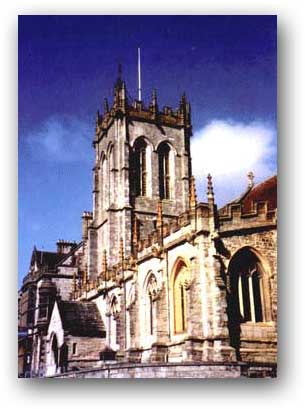
Introduction
The tower has eight bells dating from 1734; the heaviest bell (tenor) weighs just over one ton. We ring the bells regularly for Sunday morning services, usually from 9:45 to 10:30 a.m. Practices are held on Monday evenings, including virtually all Bank Holidays, from 7:30 to 9:00 p.m. We also ring for weddings, religious and civil occasions, and, half-muffled, on Remembrance Sunday. The bells rang to celebrate the new millennium, adding their music to the noise of New Year revellers gathered around the Town Pump.
We are always extremely happy to welcome anyone who may be thinking about learning to ring, and, of course, visiting ringers are always heartily welcome. We ring a fairly broad range of methods, from Grandsire and Plain Bob to Surprise Minor, by way of Oxford Bob Triples, and whatever else happens to take our fancy at the time.
Change Ringing
Bell ringing has called Christian people to worship over at least the last Millennium, but the English tradition of Change Ringing is unique, in that the bells are rung 'full circle'. This enables the movement of the bells to be controlled precisely, and sequences (or changes) of each of the different notes varied over time. Methods comprise sets of such changes, and can be extended over periods of three hours or longer to form a peal (5040 changes).
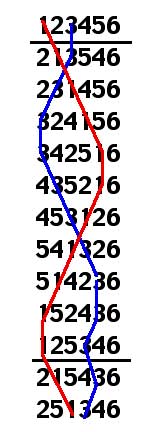
This diagram (shown above) shows a lead of a method called Grandsire Doubles. Each line shows the bells, each ringing once in a 'change'. The tenor, the bell with the lowest note, numbered 6, follows after all of the other bells have rung.The treble, the lightest bell, numbered 1, hunts up from the front (or lead) to the back, and then down again to the lead (ahead of the tenor, following the path shown in red). In this method, the second bell follows a similar path, following in the footsteps of the treble.
The other three bells follow the work of the method. The path of the third bell is shown by the blue line. It starts by striking twice in thirds place, then hunts down to the front, leads twice, and hunts up to the back, then again makes places. After that, before returning to the front, it dodges with the 4th bell.
The diagram shows that there are 10 changes before the treble returns to its starting position. If the diagram is extended until all of the bells return to their start positions, 30 changes are required. This is known as a 'plain course' of the method. 'Bobs' and 'singles', which change the work of the bells, can then be added to enable the maximum of 120 changes to be rung without repetition. This is known as an extent. As 120 = 5*4*3*2*1 = 5! (5 factorial) this corresponds to the total number of different changes that can be rung on five bells, and takes about 5 minutes to ring. With 7 bells, a true peal of 5040 changes can be rung, this takes over 3 hours. We do not ring many peals.
Change Ringing dates from the early 17th century, and Fabian Stedman's book Campanalogia, published in 1677, is the earliest book which describes the subject in detail. More familiar, perhaps, is Troyte's On Change Ringing (1869), which is quoted extensively in Dorothy L Sayers' popular 1934 detective story, The Nine Tailors. Before change ringing was invented, Call Changes, in which successive changes are called out individually, was widely practised; this form still dominates in Devon and Cornwall.
It can be appreciated that, in addition to its ecclesiastical function, change ringing has social, historical, musical, acoustical, and mathematical aspects, in addition to the satisfaction gained in exercising and improving an unusual skill. All of these, to varying extents for different people, contribute to its popularity.
St Peter's Society of Change Ringers
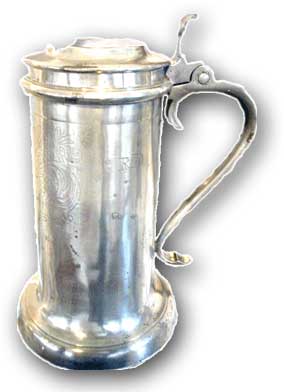
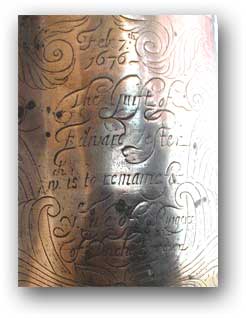
Images of flagon and inscription © Dorset County Museum 2005 reproduced by kind permission
A unique pewter ringers' flagon dated 1676, formerly used by the ringers, is now kept in the Dorset County Museum, next to the church. The flagon, which was restored in 1932, is fifteen inches high, weighs ten and a half pounds and holds approximately one and a quarter gallons. The inscription on the front is as follows:
Feb. 7th: 1676. The gift of Edward Lester wch is to remaine for ye use of ye ringers of Dorchestr for ever. St Peter.
The Society is affiliated to the Salisbury Diocesan Guild of Ringers, and to the Dorset County Association of Church Bell Ringers, both of which exist to foster the science and art of Change Ringing. We are always keen to welcome new members, either experienced ringers, or those who may be willing to learn how to ring, and participate in an enjoyable pastime. If you may be interested, please get in touch with the Tower Captain, or the Tower Secretary, who are listed on the St. Peter's Church Page
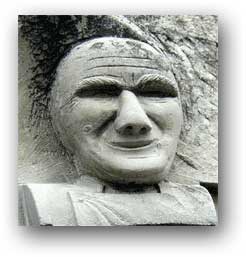
Gargoyle commemorating the late Richard Duke, Master of the Society for many years.
The bells
According to a return of 1550 the tower then contained five bells (noted in Hutchins'History of Dorset). A ring of eight was cast in 1734 at a cost of £191 4s. 6d., by Thomas Bilbie, whose foundry was at Chewstoke. (This, according to Dalton, [see Bibliography] is despite the inscription on the tenor, which mentions only six bells.) The same founder re-cast the treble in 1750; the 2 was re-cast in 1803 by Thomas Castleman Bilbie of Cullompton.
These would have been the bells ready to ring a warning of an invasion by Napoleon, and in celebration of victory at Trafalgar.
In 1889, three bells (the 4, 6, and 7) were re-cast, and the whole peal was re-hung by John Warner and Sons of Cripplegate, London at a cost of £300. John Taylor of Loughborough fitted ball bearings to the bells in 1937, and the same firm has undertaken most of the repairs and replacements since then, the last major works being in 1986.
The bells are set between the keys of E natural and E flat and have the following diameters and approximate weights:
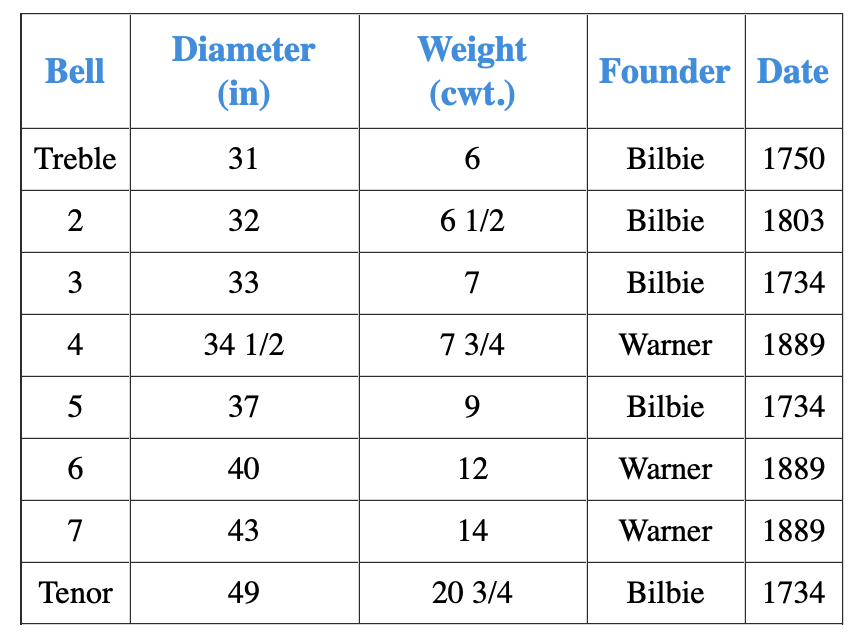
The bells carry the following inscription;
Treble
Mr. John King and Mr. Thomas Jones, Churchwardens, 1750. T. Bilbie fecit.
2
This bell was re-cast in the year 1803. George Frampton and John Cooper, Churchwardens. T. Bilbie, Cullompton, fecit.
3
The gift of Robert Brown, Esq.
Althou' my sound it is but small,
I will be heard among you all.
Mr. Daniel Arden and Mr. Joseph Gigger, Churchwardens, 1734. T. Bilbie fecit.
4
Mr. Daniel Arden and Mr. Joseph Gigger, Churchwardens, 1734. T. Bilbie fecit.
Bells no. 4, 6 and 7 re-cast, and the whole peal re-hung by public subscription at a cost of £300 0s 0d, A.D. 1889. A. H. Lock, Mayor. J. Warner and Sons.
5
Mr. Daniel Arden and Mr. Joseph Gigger, Churchwardens, 1734.
George Richards, Esq., Mr. Renaldo Knapton, Mr. Thomas Loder, Mr. Thomas Cooper, Mr. William Bryer, Bilbie fecit.
6
Re-cast by John Warner and Sons, London, 1889 (on waist).
Re-cast 1889. J. Marvin Lock, Robert Holland, Churchwardens.
God send us good luck.
7
Re-cast by John Warner and Sons, London, 1889 (on waist).
Re-cast 1889. Rev. Thomas Kingdon Allen, Rector.
Come let us go up to the house of the Lord.
Tenor
Mr. Renaldo Knapton saw me cast the 21st September, 1734. Mr. Daniel Arden, Mr. Joseph Gigger, churchwardens. Thomas Bilbie cast all these six bells.
Ring to the praise of God.
The Ringing Chamber
The ringing chamber contains a large peal board recording the details of peals rung for the Salisbury Diocesan Guild of Ringers on the bells, together with smaller boards with details of other peals and quarter peals. It also contains a small library.
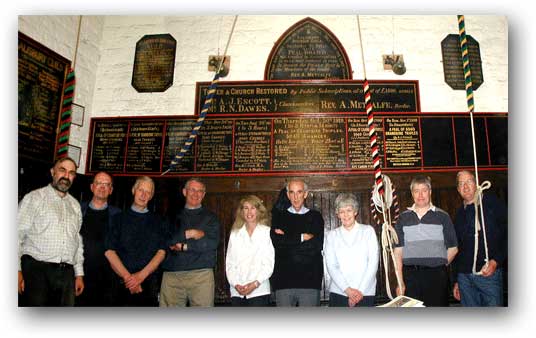
The bells could be rung in two different ways, in addition to ringing in the traditional manner.
The first of these was by means of the Ellacombe Chiming Apparatus. This device was invented in about 1850, by the Revd. H.T. Ellacombe of Devon, to allow a single person to chime the bells. Until about 1995, it was in regular use on the first Sunday of the month, and the congregation was welcomed to services by the sound of hymn tunes rung on the bells.
Secondly, there is a Silent Ringing Apparatus, which is, unfortunately, no longer serviceable. This was installed early in the last century, for teaching purposes. It may also have been used for practice during World War II, when bell ringing was forbidden until 1943, unless to sound a general alarm. The bell clappers would have been tethered, and the bells rung in the normal way. Although the bells themselves were silent, an arrangement of levers and pulleys actuated the clappers of a set of hand-bells mounted around the walls of the ringing chamber so that the ringers could gain some feedback from their efforts. Two of these bells are visible in the picture above the large peal board . Nowadays, computers can sometimes be used to help learners in much the same way.
Bibliography
|
1
|
A Guide to St. Peter's Church published in loose leaf form in about 1985 provided much of the information used in this website, and is gratefully acknowledged. |
|
2
|
For much detailed information about the bells and fittings, there is no better source than Christopher Dalton's book The Bells and Belfries of Dorset, Part I. Upper Court Press 2000. |
|
3 |
Please click here for information about the Bells at St Georges Church in Dorchester. |
|
4
|
The Dorset Towers website http://www.dorsettowers.ndo.co.uk contains much practical information, and also houses the website of the Dorset County Association, with details of DCA and SDGR practices and other events. |
|
5
|
The SDGR website http://www.sdgr.org.uk/ has information about the Guild, its events and meetings, and links to the Salisbury Diocesan website. |
|
6
|
Michael Day's Dorset Churches websitehttp://www.bath.ac.uk/~lismd/dorset/churches/ includes a number of useful references. |
|
7
|
Felstead Peal Records http://www.ringing.org/main/pages/felstead-peals?tower=1536 contains a record of all of the peals rung at St Peter's bells from 1902 to the present day. |
|
8
|
The website of the Central Council of Church Bell Ringers http://www.cccbr.org.uk/ contains numerous links dealing with all aspects of bells and bell ringing, its history, and organisatron. It is recommended to anyone tempted to find out more about the different facets of the subject. |